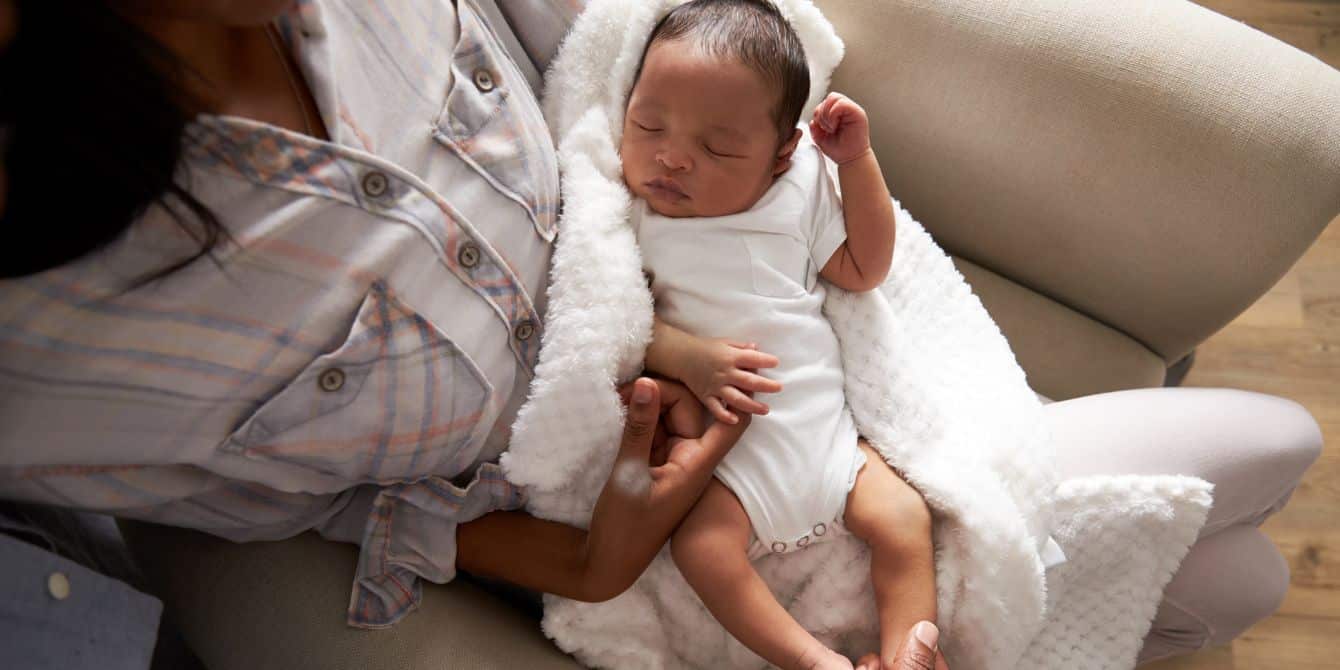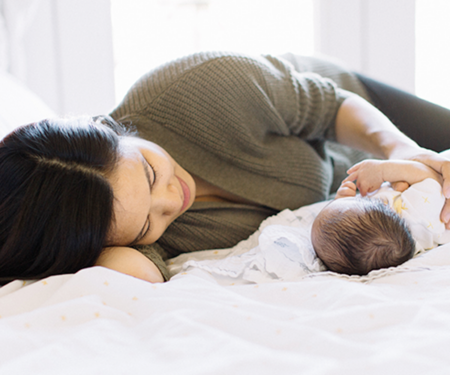It’s science: This 5-minute walk-sit routine can help your baby fall asleep faster
New research shows a specific (but simple!) routine could help parents get a crying baby to sleep.

Monkey Business Images/Shutterstock
Everyone who’s not your child’s parent seems to have a magic trick to get your baby to sleep, don’t they?
A new study in Current Biology has its own recipe for success that authors say can increase the odds of getting crying babies to sleep.
Kumi Kuroda, PhD, a researcher from the RIKEN Center for Brain Science in Japan, who led the study, gauged how weepy infants were physiologically impacted by being held, carried, and laid down.
Related: Taking vitamin D during pregnancy may lower your baby’s risk of eczema
Her team says their “transport response,” which involves a series of processes, worked to calm infants down and lower their heart rates—and their findings can be applied to help you make the transfer into the crib or bassinet.
(You probably know how hard “the transfer” can go. You rock that baby off to sweet-dreams land and then try to place them in their crib… then, poof, they’re awake again. Probably crying again, too!)
The researchers used ECG machines and video cameras to compare changes in infants’ heart rates as people acted out activities used to help little ones nod off. They carried babies, pushed them in strollers and held them while sitting. Then they recorded the data to look at patterns.
How to get a baby to sleep, according to science
What worked best? Walking for five minutes promoted sleep for babies who were crying. All of them stopped crying and had slower heart rates after a 5-minute stroll—and about half of them were asleep before the 5-minute mark. But walking didn’t help the babies who were already calm get to sleep.
And sitting and holding crying babies without walking? Researchers say it didn’t help them calm down—in fact, the babies’ heart rates tended to rise and they kept crying.
Related: AAP releases new 2022 safe sleep guidelines: Here’s what parents and caregivers need to know
The researchers also found that the babies heart rates increased if the caregiver turned or stopped walking. Being separated from the person was the most significant. (This is the root of why “the transfer” is so tough, right?)
But if parents then sat and held their infant for a specific length of time after walking to soothe, the transfer to the cot to keep them asleep was more successful.
Walk, then sit
When your baby is fussing and can’t get to sleep, Dr. Kuroda recommends that caregivers carry them while walking for 5 minutes (avoiding abrupt movements). Then sit with the baby for 8 minutes, and then lay the infant down to sleep. This 13-minute process had the best results for baby sleep in the study.
Here are more tips that Dr. Kuroda gave Motherly:
- Walk in a clear, flat indoor environment.
- Support the baby’s head and keep them snug in your arms. A baby sling or carrier may help (but you’ll need to transfer the infant out of that to get them into their crib).
- Keep a steady walking pace.
- Do not run or hop.
- If the baby still cries after 5 to 10 minutes of carrying, stop walking and check the baby’s wellness.
Related: The one thing your child needs to get ready for kindergarten? More sleep, says AAP
Knowing what works (or not)
Patti Read, a pediatric sleep consultant from New Jersey who was not part of the research, says parents and caregivers should feel free to try this.
“And if it doesn’t work, don’t get discouraged,” Read says, citing how hard it can be for babies to get to sleep.
The study only included infants up to 7 months, and only 21 babies, she points out.
After 4 months, a baby ideally shouldn’t be put into their crib completely asleep—they should be drowsy but awake so they learn how to fall asleep on their own. That can help you master how to get your baby to sleep in a crib.
Related: Dr. Harvey Karp’s secrets to sleep training a toddler
“This is because if a baby cannot put themselves to sleep, then they will need the assistance of a parent to walk and sit with them every single time they wake up,” Read notes.
Read likes the tips from famed pediatrician Dr. Harvey Karp on the five Ss, which are similar to Dr. Kuroda’s tips.
“I don’t think there is that much that we don’t know about getting babies to sleep, it’s just there are a lot of factors going on in their little growing bodies and again every baby is different, so it’s never going to be exactly the same for every baby,” Read says.
“Unfortunately, since they can’t tell us what is going on and they can’t understand what we say to them, it’s harder to teach them how to fall asleep on their own,” she adds.
Unlocking the mysteries of baby sleep
Dr. Kuroda says more studies are needed to verify her findings. The research doesn’t explain why some babies cry uncontrollably and/or do not sleep, the study authors write. The researchers do want to develop a wearable device that will let parents see the physiological states of their babies on a smartphone in real time.
“Like science-based fitness training, we can do science-based parenting with these advances, and hopefully help babies to sleep and reduce parental stress caused by excessive infant crying,” Dr. Kuroda says in a statement.
Dr. Kuroda also says that the results are limited because they only measured day activities—not infant responses in the evening or overnight.
“I cannot conclude from the article if the heart rate measurements are accurate enough to work,” adds Heidi Holvoet, PhD, a baby sleep consultant from Belgium and the founder of Baby Sleep Advice.
Related: Sleep like a baby: Your expert guide to 12 months of rest
She notes that heart rates may give an indication of the baby’s state after walking to soothe them, but it’s the type of sleep phase a baby is in that determines how easily they stay asleep.
Holvoet also questions how accurate the method is for all babies at all ages—something that Dr. Kuroda wants to study more.
“We don’t know the one-fits-all mathematically reliable method to get babies to sleep, but I don’t think we need it,” Dr. Holvoet says.
“I believe we have all the knowledge in place, though, to help babies sleep; by acknowledging their development and natural abilities at any given age, as well as each baby’s own unique personality and needs,” she adds.
The bottom line
As a mom to one kiddo who didn’t sleep well when he was a baby (and woke me up at 4:15 a.m. today—but who’s keeping tabs?) I can tell you that this is just one small study, and not to fret if the methods don’t work for you. There are plenty of other studies (and tons of books) that can help you learn about how to get your baby to sleep. What ultimately works? That depends on you and your baby. It’s a mystery that you may never “solve,” and that’s totally OK.
Featured experts
Heidi Holvoet, PhD, is a baby sleep consultant from Belgium and the founder of Baby Sleep Advice.
Kumi Kuroda, PhD, is a researcher from the RIKEN Center for Brain Science in Japan.
Patti Read is a pediatric sleep consultant from New Jersey who runs Goldilocks Sleep Solutions.
Sources
Ohmura, N., et al. A method to soothe and promote sleep in crying infants utilizing the transport response. 2022. Cell Biology. Doi: 10.1016/j.cub.2022.08.041
Douglas, P., et al. The crying baby: what approach? Current Opinion in Pediatrics, 2011. doi: 10.1097/MOP.0b013e32834a1b78
Bregje, E., et al. Swaddling: A Systematic Review. Pediatrics, 2007. Doi: 10.1542/peds.2006-2083
